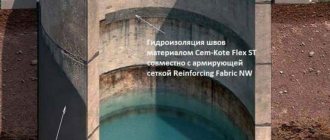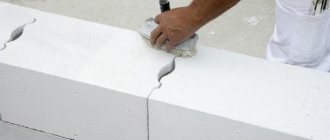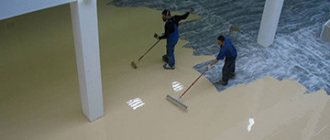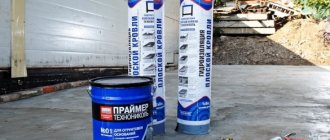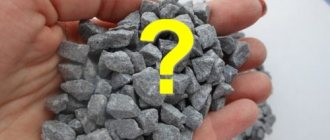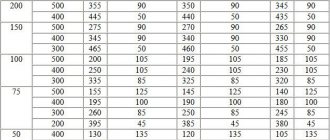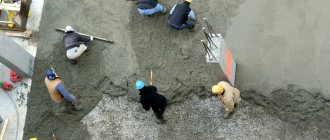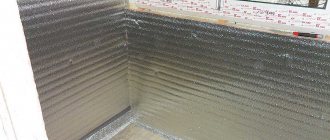Beton-House.com
Website about concrete: construction, characteristics, design. We combine the experience of professionals and private craftsmen in one place
Ceiling painting
Many materials and techniques are used to finish the ceiling surface. They all have their pros and cons.
In our article, we will look at what painting a concrete ceiling is, why, with the advent of modern cladding methods on the market, this type of base decoration has still not lost its relevance, and we will analyze what types of compositions are used.
- Acrylic
Do I need to treat the ceiling before painting?
If you are in doubt whether you need to prime the ceiling before painting the old paint, this is necessary if the previous layer consists of water-based paint, and the new color will be different from the old one. If it is nitro enamel, then it needs to be sanded and then primer applied - this way the new color will last longer.
Interesting materials:
How to preview photos in Windows 10? How to make a second screen in Windows 10? How to check spelling in Word? How to make Roman numerals in Word? How to make a bath white? How to visually make the ceiling higher? How to visually make ceilings higher? How to make a bedroom instead of a kitchen? How to make a capital font capitalize? How to make a yellow sole white?
Basic methods of paintwork
To apply the coloring composition use:
- brushes;
- rollers;
- spray gun.
Choosing a tool for painting the ceiling.
Painting with a roller takes less time. When choosing a roller, it is recommended to pay attention to the seams of the material (this affects the result of the work).
For textured surfaces and hard-to-reach places, brushes are used. When working with acrylic or latex compositions, use brushes with artificial fibers (organic ones may break down and residual bristles will appear on the surface).
Spray gun
Mechanical or electrical devices allow paint to be applied evenly over the entire surface.
Before carrying out work you should:
- remove furniture from the premises;
- turn off heating radiators;
- open the windows;
- remove sources of open fire;
- Prepare a respirator, safety glasses and gloves.
Pay attention to: Painting a concrete floor
The spray gun allows you to apply paint evenly to the ceiling.
The sprayer is held perpendicular to the ceiling surface. The length of the jet ranges from 60 to 80 cm. The first layer is applied in longitudinal stripes (each subsequent one overlaps part of the previous one). Errors are hidden with the next layer.
Puttying procedure
Next, the surface is puttied with specialized solutions, which are prepared according to the following algorithm, taking into account the proportions specified in the instructions:
- powdered components are poured into a container;
- the resulting mixture is diluted with water;
- The material is stirred with a mixer until a homogeneous consistency occurs.
The portion of the prepared composition required by the master is applied to a wide spatula, after which it is transferred to a narrow version of this device, which is evenly distributed over the surface to be decorated. The work is carried out from a stepladder and is accompanied by the use of a wide plane. A container containing putty is placed there and access to the ceiling being finished is provided.
In the corners and junctions of the base with the walls, the material is applied with a 150 mm wide spatula and its corner version. High quality leveling of the plane is ensured by the first layer with a thickness of a maximum of 3 millimeters, as well as the layer created after drying with a thickness of 1–2 millimeters.
Finishing features
Painting is a durable finishing option that, with low labor costs, will allow you to obtain a beautiful, smooth surface. The material will not fade, peel or wear off. A well-chosen solution will help optically change the incorrect configuration of the room.
Material for dyeing Source sdelaipotolok.com
Decorative finishing gives a textured effect. There are 4 types of coatings:
- Glossy. The enamel shines, reflects light well and visually enlarges a small space. The higher the degree of smoothness, the more durable the material. The varnished texture emphasizes the slightest cracks and irregularities, so the surface must be perfectly prepared before application.
- Matte. Velvety ceiling paint does not shine and hides defects in the area. The porous structure of the coating absorbs dust and dirt, making the area above your head difficult to wash.
- Semi-gloss. The material has a light reflective effect and is not afraid of mechanical damage. Perfect for compact spaces, masks defects.
- Semi-matte. The slightly velvety finish is resistant to stains and wear.
Coating with varnish texture Source rusoboz.ru
The higher the hiding power, the fewer layers will be required to cover the base color. Manufacturers offer 4 classes, the details of which are indicated on the label. Ceiling paint with a coefficient of 1 will repaint a black base white in 2 approaches. At low rates, enamel consumption increases and the decorative effect of the finish is lost. Often the amount spent on expensive material is lower than that of cheap analogues.
Velvety covering over the head Source natjazhnye-potolki-rostov.ru
Dyeing technology
You can paint concrete with your own hands quite quickly and easily.
The presented step-by-step instructions stipulate how to do this correctly:
- The first step is to completely get rid of the old paintwork, if any. Use a stiff wire brush or scraper to clean the finish. This work is quite long and labor-intensive, but the quality of the coating created depends on it;
- Next, you should remove accumulated dust, dirt, oil and grease stains from the surface. Oil stains can be removed using an orthophosphorus solution. After this cleaning, you must wait until the concrete base is completely dry and only then proceed to the next stage of work;
Advice. the paint may have a different shade in different areas
Related discussions
Concrete ceilings without finishing. Pros and cons.
Loft style interior
Ariana Ahmad Interior Design
Fix it with a special varnish and that’s it!
- Likes: 1
- Save
Natalya Maximenko Design
In my loft-style project, I simply sanded the ceiling and coated it with a transparent, colorless matte varnish.
All the joints, some “flaws” in the ceiling - everything remains - this is what gives the concrete its unique style. No plaster is needed if you want to highlight the beauty of concrete.
I consider it mandatory to cover with matte varnish.
- Like | 7
- Save
Julia Zapevalova
Natalia, please tell me 1. what varnish would you recommend? (company) 2. Will it be possible to apply paint later without removing the varnish layer if I understand that the concrete ceiling is not mine?
3. Why matte and not glossy?
4. Is sanding necessary?
5. Does it end up being cheaper than painting or not?
Thank you very much for your answers!
- Like
- Save
- Like
- Save
- Like | 3
- Save
Tatiana Mikhaylova interior designer
Good day, Sergey! Here is a simple ready-made and inexpensive solution. This is at my facility, a little unfinished yet, but the principle is clear. The ceiling was cleared of adhering dirt, the wide gap between the slabs was covered with plaster (to prevent crumbs from falling off from the inside), there was a polyurethane cornice with LED lighting around the perimeter, and there was real brick on the wall, slightly tinted. Everything is covered with clear varnish.
Concrete ceiling in the interior of an apartment or private house - how to cover it and whether it should be done
Fashion trends set their own criteria for interior design. As a result, designers do not stop at the heights they have conquered, but develop creativity, offering fresh ideas. The concrete ceiling was a special find for creating a modern room.
The composition of heavy material ends with stylish sophistication, combining simplicity with luxury, destroying the stereotypical vision of design preferences and forcing you to take a fresh look at the design of your home.
How to choose putty for a concrete base
Floor slabs, in fact, cannot be without flaws; traces from the formwork structure, holes from air bubbles, and much more remain on the finished products. Therefore, an experienced puttyer uses two types of material: starting and finishing putty.
The starting composition is more rough; its main use is primary finishing. The material is plastic, so it is easy to apply and level. In case of significant defects, it is allowed to apply the starting mixture in a layer of up to 1.5 cm. This material is not capable of making the base perfectly smooth, but it can act as a base for the finishing coat.
The finishing mixture eliminates any ceiling defect and makes the surface absolutely smooth. This is achieved by finely grinding the powder. The composition can be applied in a layer of up to 3 mm. After drying, the composition should be sanded. There are universal putty mixtures suitable for both starting and finishing finishing.
In order to perform high-quality preparation of the ceiling space for painting, it is better to choose both the starting and finishing mixture of the same brand. This greatly improves the adhesion of materials to the surface and to each other.
It is necessary to consider the conditions under which painting will be carried out. For example, in rooms with high humidity it is necessary to use compounds that have water-repellent properties.
While learning the basics of puttying a concrete ceiling, we must not forget about the safety of the material. It is worth carefully studying the composition of the mixture for the presence of substances harmful to humans and the environment.
Coloring
After all the preparatory work has been completed, you can begin to prepare the coloring solution for use. This is not difficult - you just need to mix it thoroughly or dilute it a little according to the recommendations indicated on the package. Best of all, a special attachment for a drill is suitable for mixing. This will allow you to mix the coloring composition evenly. If such a tool is not at hand, you can get by with any other suitable device.
Choosing the right paint is also important. Typically, everyone’s favorite water-based paint is used for concrete surfaces. However, there are other types of paints and varnishes in stores and you can choose the type that best suits your characteristics. The only thing you should avoid is oil paints - they turn yellow over time and create a too fragile coating.
The application of coatings occurs in accordance with a certain scheme. It is better to adhere to the rules below, as they have been developed over many years of work by professionals in their field. Therefore, you should paint it like this:
- Work on creating the first layer should begin from the corner closest to the window opening.
- The direction in which the first layer of paint will lie is determined so that the last of the applied layers is directed away from the window. The minimum requirement is to make two layers, each subsequent layer being rolled perpendicular to the previous one.
- In places where the ceiling meets the walls, you must first go over it with a narrow roller or brush. A brush is also used in joints, recesses of the ceiling structure and corners.
- You should not immediately paint over a large area of the ceiling - it is better to do it gradually, painting small squares.
- Several thin layers of paint are better than one thick one. It will take more time to work, but the result will be much better.
Application options in interior design
The introduction of advanced technologies in the development of interior decoration makes it possible not only to decorate a building with a concrete consistency, but also to obtain an unusual decorative coating. Thus, the mercilessness of concrete walls is transformed into a prestigious shine, reflecting all the colors of the interior when the material is expertly processed.
Now there is something to cover a concrete ceiling, and the treatment is simple. By conscientiously decorating a concrete surface, you can get an unusual design object. The majority of advanced dwellings have concrete inclusions, and the ceiling is often made from this material.
For modern living spaces, this is one of the best options, especially for the loft style. But thanks to the emergence of new materials in the interior, it is more common to use not concrete itself, but its imitation, which is much cheaper and more convenient. Surfaces in different rooms are covered in this way.
Natural concrete
Concrete is a pre-processed material, but in the last few years it has been used for interior design and finishing. The untreated plane has an unusual appearance. It looks good in urban and industrial style.
Treated concrete
The concrete ceiling in the interior can be processed in different ways, choosing the optimal look for the building.
The process is carried out in this way:
- The seams between the slabs are covered to increase interfloor sound insulation.
- They can prime, cover the surface with impregnations or varnishes to protect it from dust and cracks. These compounds fix the concrete and make it possible to carry out wet cleaning.
- The ceiling is tinted without hiding the texture of the concrete in order to reduce the roughness of the coating. For this purpose, lime or water-based paint is used.
Imitation concrete
If the surface of natural concrete does not arouse interest, but at the same time you want to preserve the special industrial style of the apartment, you can use an imitation of the material.
In this case, use the following surfaces for a concrete ceiling in the interior:
- Modular slabs. They are hung on the ceiling and do not require further decoration. Fastening is carried out using metal fasteners or by gluing. The slabs are suitable for installation on suspended ceilings. Color and texture are presented in a wide range.
- Special textured paints for the home. They contain mineral additives and transformative preparations that help ensure a special distribution of paint pigments throughout the entire surface. The result is unevenness and areas of varying tones, giving the illusion of a wet or dry cement slab. Immediately after application, you can touch the paint layer with a putty knife to create streaks, indentations and other imperfections.
- Decorative plaster allows you to simulate a special plane close to reality. The plaster is applied in a thick layer, including creating an imitation of joints between the slabs on the plane. You can also imitate cracks and prints, if required by the project.
You can treat the damp surface with a sponge using original movements to make the ceiling surface rough. Using different tools, it's easy to achieve any style. After all the steps, a top layer of varnish or wax is applied to the ceiling.

